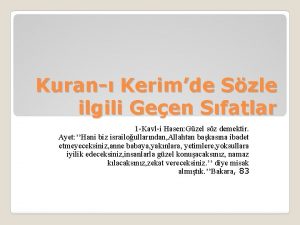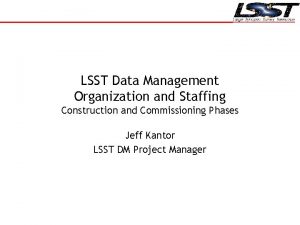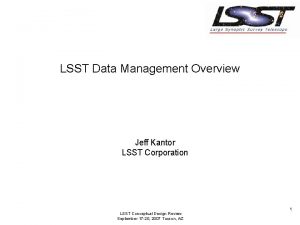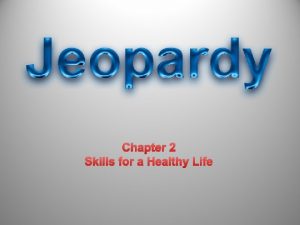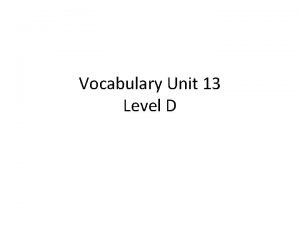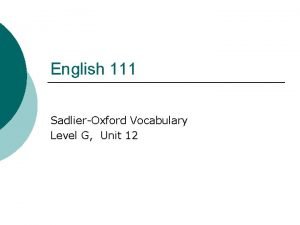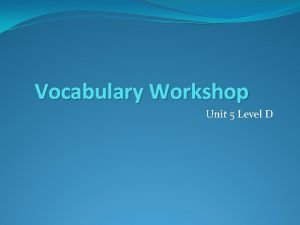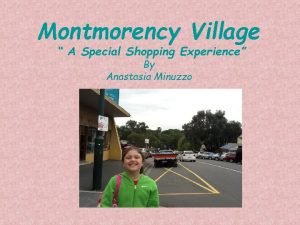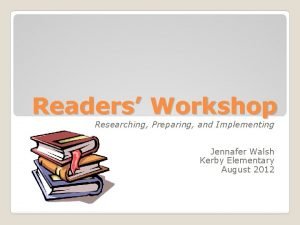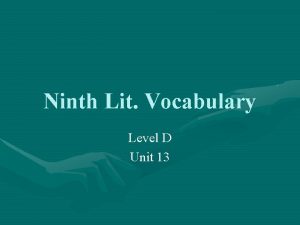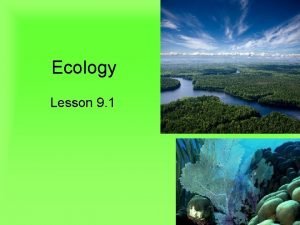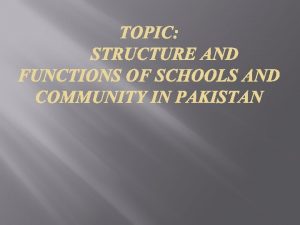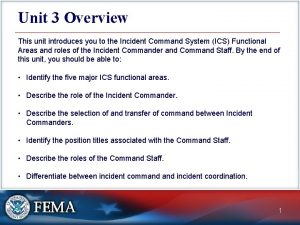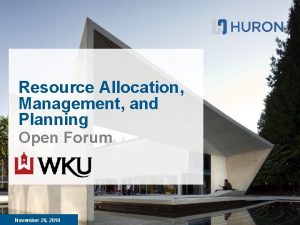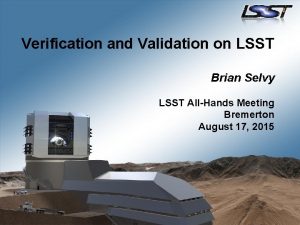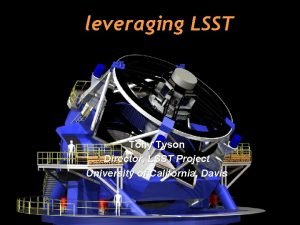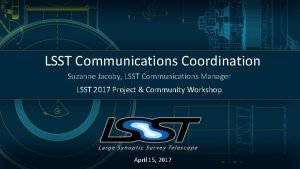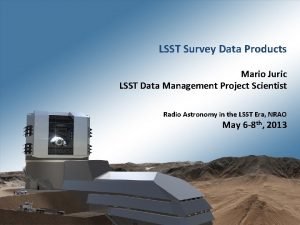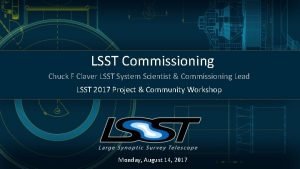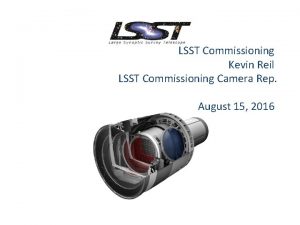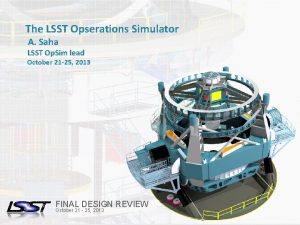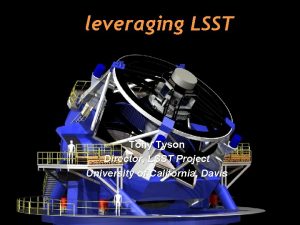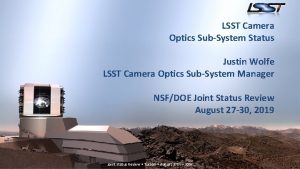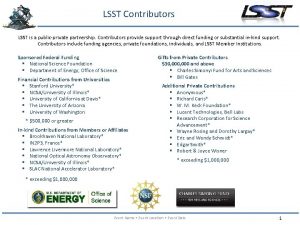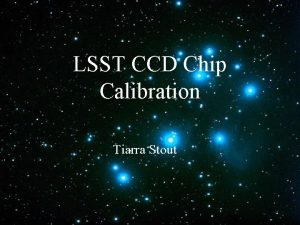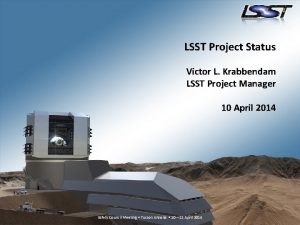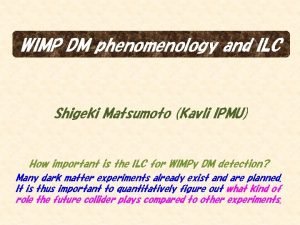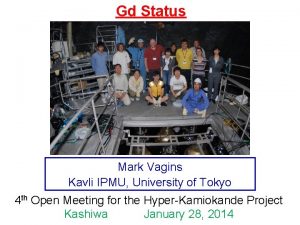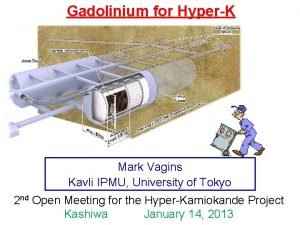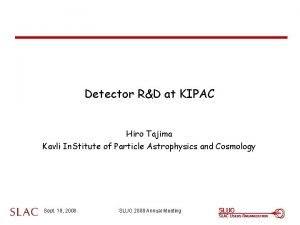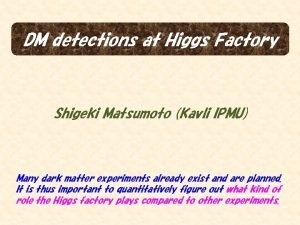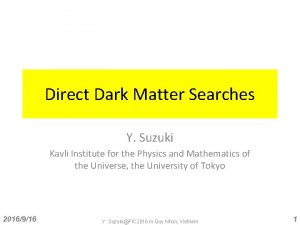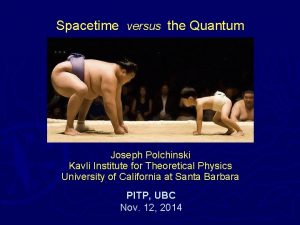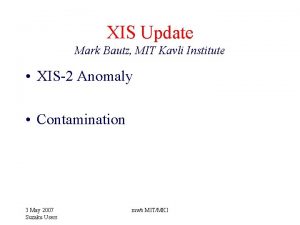LSST Community Workshop Welcome and Kavli LSST Resources
















![Ad hoc Infrastructure-focused Study Group Topics [led by Rachel Street, LCOGT] 1. Infrastructure for Ad hoc Infrastructure-focused Study Group Topics [led by Rachel Street, LCOGT] 1. Infrastructure for](https://slidetodoc.com/presentation_image/c3038bfc711c4e93d800e616efc9b0e8/image-17.jpg)














- Slides: 31

LSST Community Workshop – Welcome and Kavli LSST Resources Study 1

What to expect in this session • Overview of LSST 2016 • Report on the Kavli Community Study of the OIR Resources Needed to Maximize LSST Science [BW] • Report on LSST Science Collaboration Activities [LW] 2

LSST 2016 • • • Wifi: SSID=LSST; Password=WVZQA Twitter hashtag: #LSST 2016 URL for exit survey will be available by the end of the meeting 3

LSST 2016 4

LSST 2016 • • Parallel joint DOE/NSF Status Review Tuesday – Thursday Wednesday am Community-focused plenaries on LSST science resources and collaborations, Data Management basics. Afternoon breakouts • • Wednesday evening public outreach event, starring Lucianne Walkowicz, at 7 pm Thursday am Project and Community plenary on Dynamics of Large Collaborations + Successful Meetings. Afternoon breakouts. • • Thursday evening Unconference at 7 pm Friday 9 am – Prep for breakout report back talks and hacking, 11 am – Report back talks. 5

6

A public, Project. and Community mixer will follow Lucianne’s talk Free snacks+soft drinks, cash bar Binocular observing, weather permitting 7

Wednesday aka today

Thursday

http: //www. noao. edu/meetings/lsst-oirstudy/



August 26, 2015 – A letter from Jim Ulvestad to Matt Mountain, Dave Silva, and Steve Kahn

The study report aims to be informational to federal and private funding sources as well as public and private observatories to (i) guide funding priorities and (ii) facilitate crossfacility, and cross-science field collaborations.

• • • Winter 2015: Open call for community input on capabilities needed to maximize their LSST science (>100 responses) Feb-Mar 2016: Convened 6 study groups Mar-Apr 2016: Quantitative studies of needed capabilities May 2016: Workshop to discuss and synthesize results and findings Summer 2016: Prepare report [to be released ~early September]

Science Study Group Topics 1. Using Small Solar System Bodies to Understand the Evolution of the Solar System 2. Rotation and Magnetic Activity in the Galactic Field Population and Open Star Clusters 3. Probing Galaxy Formation and the Nature of Dark Matter and Gravity in the Local Group 4. Characterizing the Transient Sky 5. The Co-Evolution of Baryons, Black Holes, and Cosmic Structure 6. Facilitating Cosmology Measurements with LSST
![Ad hoc Infrastructurefocused Study Group Topics led by Rachel Street LCOGT 1 Infrastructure for Ad hoc Infrastructure-focused Study Group Topics [led by Rachel Street, LCOGT] 1. Infrastructure for](https://slidetodoc.com/presentation_image/c3038bfc711c4e93d800e616efc9b0e8/image-17.jpg)
Ad hoc Infrastructure-focused Study Group Topics [led by Rachel Street, LCOGT] 1. Infrastructure for a Time Domain Follow-up System and the Evolution of Observing Paradigms 2. Computing Infrastructure Required for LSST

Study group work The study groups drilled down on each illustrative science topic to identify, quantify, and prioritize (critical, very important, important) the resources needed to fully exploit the science enabled by the LSST dataset. For telescopes/instruments – This included quantifying the attributes of the needed instruments [e. g. wavelength range, FOV], and the amount of time necessary to accomplish the science goals.

Study Findings Diverse facilities will enable LSST science Workhorse instruments will enable a broad range of science, e. g. wide-field optical imaging, wide-field MOS, broad-wavelength medium res spectrograph, hi-res optical spectrograph A parallel need for infrastructure investments Further work is needed to understand support the computing requirements Our high priority findings overlap strongly w/ Elmegreen report findings

Study Recommendations Critical resources in urgent need of a clear development path Develop or obtain access to a highly multiplexed, wide-field optical multiobject spectroscopic capability on an 8 -m or larger class telescope, preferably in the Southern Hemisphere Critical resources that have a potential development path Deploy a broad wavelength coverage, moderate resolution (R = 2000 or larger) OIR spectrograph on Gemini South Ensure the development and early deployment of an alert broker[s], scalable to LSST, and provide access to a diverse suite of facilities for alert triage and urgent follow-up

Study Recommendations Critical resources that exist today Support into the LSST era high-priority OIR capabilities that are currently available, e. g. DECam and NIFS on Gemini, among others Infrastructure resources and processes in urgent need of development Support development of observatory infrastructure that enables efficient deployment of follow-up programs Regularly review computing needs and support for analysis and discovery tools Continue community planning and development

Connection to Elmegreen Report Recommendation #2: NSF should direct NOAO to administer an ongoing community-wide planning process to identify the critical Optical and Infrared System capabilities needed in the near term to realize the decadal science priorities. NOAO could facilitate the meeting of a system organizing committee, chosen to represent all segments of the community, which would produce the prioritized plan. NSF would then solicit, review, and select proposals to meet those capabilities, within available funding. Our study takes initial steps in this direction, having carried out a community-based study of the OIR capabilities that are needed to realize decadal science in connection with the use of LSST.

Connection to Elmegreen Report Recommendation #3: The National Science Foundation should support the development of a wide-field, highly multiplexed spectroscopic capability on a medium- or large-aperture telescope in the Southern Hemisphere to enable a wide variety of science, including follow-up spectroscopy of Large Synoptic Survey Telescope targets. Examples of enabled science are studies of cosmology, galaxy evolution, quasars, and the Milky Way. We find that wide-field highly multiplexed optical spectroscopy on 3– 5 m and 8– 10 m telescopes is a high-priority capability for LSST science. Among the science cases considered here, it is critical to LSST-based studies of stellar rotation and activity, dark matter, the Milky Way and the Local Group, galaxy evolution, and cosmology.

Connection to Elmegreen Report Recommendation #4 a: The National Science Foundation should help to support the development of event brokers, which should use standard formats and protocols, to maximize Large Synoptic Survey Telescope transient survey follow-up work. Our study confirms the importance of brokers.

Connection to Elmegreen Report Recommendation #4 b: The National Science Foundation should work with its partners in Gemini to ensure that Gemini South is well positioned for faint-object spectroscopy early in the era of Large Synoptic Survey Telescope operations, for example, by supporting the construction of a rapidly configurable, high-throughput, moderate-resolution spectrograph with broad wavelength coverage. We find that a high-throughput spectrograph with broad wavelength coverage (0. 36– 2. 5 micron) and moderate resolution (R = 2000 or larger) is a high priority for LSST science. It is a critical capability for characterizing small bodies in the Solar System, understanding the transient universe, and galaxy evolution. The Gem 4#3 instrument currently under development for Gemini is a valuable opportunity to provide this capability.

Connection to Elmegreen Report Recommendation #4 c: The National Science Foundation should ensure via a robustly organized U. S. Optical and Infrared (OIR) System that a fraction of the U. S. OIR System observing time be allocated for rapid, faint transient observations prioritized by a Large Synoptic Survey Telescope event broker system so that high-priority events can be efficiently and rapidly targeted. While we did not delve deeply into the question of how observing time should be allocated to support observations of transient phenomena, our study strongly supports the need for a robustly organized US OIR System (of telescopes, instruments, and other observing infrastructure) in order to maximize the science from LSST discoveries of transient phenomena.

Connection to Elmegreen Report Recommendation #4 d: The National Science Foundation should direct its managing organizations to enhance coordination among the federal components of medium- to large-aperture telescopes in the Southern Hemisphere, including Gemini South, Blanco, the Southern Astrophysical Research (SOAR) telescope, and the Large Synoptic Survey Telescope (LSST), to optimize LSST follow-up for a range of studies. Our study identified potential roles for Gemini (e. g. Gem 4#3, GHOST), Blanco (e. g. DECam), SOAR (e. g. time domain follow up) in maximizing LSST science.

Connection to Elmegreen Report Recommendation #5: The National Science Foundation should plan for an investment in one or both Giant Segmented Mirror Telescopes in order to capitalize on these observatories’ exceptional scientific capabilities for the broader astronomical community in the Large Synoptic Survey Telescope era, for example, through shared operations costs, instrument development, or limited term partnerships in telescope or data access or science projects. Although GSMTs were not a primary focus of our study, our study identified multiple important roles for GSMTs in maximizing LSST science. The science cases considered here place high priority on AO-fed integral field unit (IFU) imaging and spectroscopy, NIR imaging, NIR spectroscopy, and broad wavelength high throughput spectroscopy with GSMTs.

Related mid-decadal findings FINDING 3 -2: Current projections for LSST performance and data products promise transformational scientific impact, as envisioned by NWNH. To realize the full scientific potential of this great new facility, funding that enables individual investigators and groups of investigators to deliver the scientific results will be critical. FINDING 3 -12: Even following the divestment recommended by the Portfolio Review, the operations costs of ALMA, DKIST, and LSST will compromise the ability of the U. S. community to reap the scientific return from its premier groundbased facilities. Moderate increases in the NSF-AST budget would have highly leveraged science impact as a consequence of these powerful new facilities. 29

Related mid-decadal recommendations RECOMMENDATION 3 -1: The NSF should proceed with divestment from groundbased facilities that have a lower scientific impact, implementing the recommendations of the NSF Portfolio Review, which is essential to sustaining the scientific vitality of the U. S. ground- based astronomy program as new facilities come into operation. RECOMMENDATION 3 -2: The NSF and the National Science Board should consider actions that would preserve the ability of the astronomical community to fully exploit the Foundation’s capital investments in ALMA, DKIST, LSST, and other facilities. Without such action, the community will be unable to do so because at current budget levels the anticipated facilities operations costs are not consistent with the program balance that ensures scientific productivity. 30

The end 31
 Szle
Szle Lsst
Lsst Lsst
Lsst Lsst
Lsst Jeff kantor
Jeff kantor Transformation processes
Transformation processes Variable resources definition
Variable resources definition Renewable resources vs nonrenewable resources
Renewable resources vs nonrenewable resources Wise men three clever are we
Wise men three clever are we The life skill using community resources means:
The life skill using community resources means: Maryland community health resource commission
Maryland community health resource commission Plan together in community mobilization
Plan together in community mobilization Vocabulary workshop level d unit 6 synonyms and antonyms
Vocabulary workshop level d unit 6 synonyms and antonyms Unit 13 vocabulary workshop level d
Unit 13 vocabulary workshop level d How to write factual description
How to write factual description Sadlier level g unit 12 synonyms
Sadlier level g unit 12 synonyms Vocabulary workshop unit 5
Vocabulary workshop unit 5 Level f unit 8 synonyms
Level f unit 8 synonyms Hair and body workshop montmorency
Hair and body workshop montmorency Pros and cons of reading workshop
Pros and cons of reading workshop Brazing hearth diagram
Brazing hearth diagram Vocab level g unit 15
Vocab level g unit 15 Synonyms and antonyms
Synonyms and antonyms Immigration definition biology
Immigration definition biology Concept of biosphere ppt
Concept of biosphere ppt Function of community in pakistan
Function of community in pakistan Scenario the deputy incident commander will be replacing
Scenario the deputy incident commander will be replacing Chapter 24 the land where continents collided answer key
Chapter 24 the land where continents collided answer key Chapter 21 section 1 landforms and resources
Chapter 21 section 1 landforms and resources Scheduling resources and costs
Scheduling resources and costs Resources and competencies analysis
Resources and competencies analysis Resources allocation and mobilization plan (ramp)
Resources allocation and mobilization plan (ramp)
